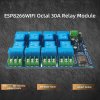As title hints I am doodeling around on how to create a somewhat staggered spin-up of my 3x Supermicro BPN-SAS2-936EL backplanes with 16 disks a pop. Those 48 disks (at this time only 28) are powered by a Corsair AX1500i which obviously are struggling with deliver the amperage when all disks boot at once, even at this point with 28 of them. Real staggered spin-up is not supported with my setup so I have to go creative. My PSU can handle all 48 disks up and running, and also handle a full row (16 disks) booting up at a time no problemo. So, how to light up each row sequentially then?
As I see it I have two options;
1. Find out on how to control the backplanes with serial/signal/jumper manipulation.
2. Go 'brute force' and use a micro controller to control the boot and control the power delivery to each of the backplanes.
Serial/signal/jumper manipulation
Is it possible to utilize any of the jumpers (or other points) on the backplanes as to halt them in giving power to the disks? I know there are a few jumpers and connectors on the backplane that are made for debug, flashing and diagnostics (EPP, MDIO, EXPDGB1), could they be used to halt the power delivery to the drives? From what I can tell there is not much usable information on the net regarding the connectors and jumpers on the BPN-SAS2-936EL. Any thoughts or insights here?
Go 'Brute Force' and use a micro controller/relays
Utilizing the 'Power Good Signal' from PSU to motherboard:
The power good signal is a +5 volts signal that is generated by a switching power supply when the supply has stabilized its output voltages and passed all its internal self-tests. This is usually generated after a period of between 0.1 seconds and 0.5 seconds after turning on the power supply.
The motherboard relies on the processor timer chip which manages a reset line to the processor. As long as the power good signal is absent, the timer chip applies a constant reset signal to the processor and the computer cannot turn on. Once the power supply completes its initialization and stabilizes its outputs, the power good signal is sent to the timer chip which in turn stops resetting the processor. The processor now starts the computer boot up process and executes the code at the ROM BIOS.
So thats my go-to here.. I cut and redirect the 'Power Good Signal' (normally grey cable on ATX) to my micro controller, the 12v and 5v power to the backplanes via my beefy relays and control it all with my micro controller (Arduino, RPi or something).
So my question here is; Do my Supermicro MBD-X12SCA-5F motherboard and the On-board IPMI BMC interfere or monitor the absence or rather the presence of the Power Good Signal sent from the PSU? If I delay it for 20-30 seconds will that have any implications?
Any thoughts or insights here?
I am very grateful for any input! (Yes, tried with SM Tech support but understandably they weren't that eager to elaborate on this)
/Lennong
As I see it I have two options;
1. Find out on how to control the backplanes with serial/signal/jumper manipulation.
2. Go 'brute force' and use a micro controller to control the boot and control the power delivery to each of the backplanes.
Serial/signal/jumper manipulation
Is it possible to utilize any of the jumpers (or other points) on the backplanes as to halt them in giving power to the disks? I know there are a few jumpers and connectors on the backplane that are made for debug, flashing and diagnostics (EPP, MDIO, EXPDGB1), could they be used to halt the power delivery to the drives? From what I can tell there is not much usable information on the net regarding the connectors and jumpers on the BPN-SAS2-936EL. Any thoughts or insights here?
Go 'Brute Force' and use a micro controller/relays
Utilizing the 'Power Good Signal' from PSU to motherboard:
The power good signal is a +5 volts signal that is generated by a switching power supply when the supply has stabilized its output voltages and passed all its internal self-tests. This is usually generated after a period of between 0.1 seconds and 0.5 seconds after turning on the power supply.
The motherboard relies on the processor timer chip which manages a reset line to the processor. As long as the power good signal is absent, the timer chip applies a constant reset signal to the processor and the computer cannot turn on. Once the power supply completes its initialization and stabilizes its outputs, the power good signal is sent to the timer chip which in turn stops resetting the processor. The processor now starts the computer boot up process and executes the code at the ROM BIOS.
So thats my go-to here.. I cut and redirect the 'Power Good Signal' (normally grey cable on ATX) to my micro controller, the 12v and 5v power to the backplanes via my beefy relays and control it all with my micro controller (Arduino, RPi or something).
So my question here is; Do my Supermicro MBD-X12SCA-5F motherboard and the On-board IPMI BMC interfere or monitor the absence or rather the presence of the Power Good Signal sent from the PSU? If I delay it for 20-30 seconds will that have any implications?
Any thoughts or insights here?
I am very grateful for any input! (Yes, tried with SM Tech support but understandably they weren't that eager to elaborate on this)
/Lennong
Last edited:
